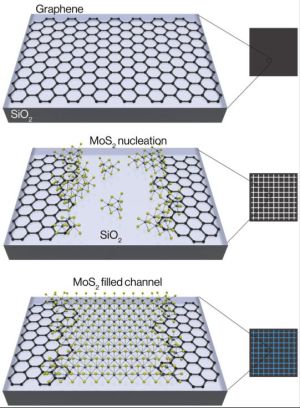How to grow electronics that are one atom thick
Ars Technica » Scientific Method 2016-07-22

Once a channel is cut into the graphene, a molybdenum disulfide crystal can grow within it. (credit: Berkeley Lab)
It's a big challenge to manipulate these things that are just one atom thick, so it's really hard to put together any sort of circuitry based on these materials. Now, however, researchers have figured out how create a template where single-atom-thick materials will grow to create functional circuitry.
As we noted above, graphene is an excellent conductor of electrons, so the authors of the new paper decided to use it to create wiring. But getting sheets of graphene lined up to consistently create the wiring of even simple circuitry has been nearly impossible. The authors didn't even try. Instead, they took a larger sheet of graphene, dropped it onto silicon dioxide, and then etched away any material they didn't want. The etching involved a plasma of oxygen ions, which burned channels in the graphene that were about 15µm wide.